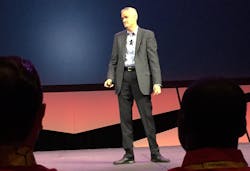Perhaps sensing that potential customers had reached their hype threshold on the Industrial Internet of Things (IIoT) concept, several automation suppliers have shifted the conversation to “digital transformation.” The risk is that if manufacturers don’t get serious about undertaking the real change that needs to happen if they’re going to survive in their respective markets, these words will end up being just as empty as those that preceded.
There is real value to be had from IIoT efforts—or digital transformation. But because it can mean so many different things to different companies, it can be difficult to nail down what it means for all. And as much as executives seem to recognize the importance of starting what many refer to as a journey, it’s not at all uncommon for them to have a difficult time even knowing where to start.
“Digital transformation is the hottest buzz phrase out there,” said Mike Train, opening this year’s Emerson Global Users Exchange in San Antonio last week. Before handing the reins over to Lal Karsanbhai, Train was speaking as executive president of Emerson Automation Solutions. “Without a clear vision or roadmap, organizations can become frozen or distracted.”
With that in mind, Emerson has launched a Digital Transformation Roadmap, including consulting and implementation services to help manufacturers develop and execute a tailored plan to use digital technologies to reach top performance.
An Emerson study of industry leaders responsible for digital transformation initiatives laid out the problem pretty plainly. Although 90 percent of the respondents agreed that having a clear roadmap was important, only 20 percent said they had a vision along with a clear and actionable roadmap for digital transformation. They also cited the absence of that roadmap as the No. 1 barrier for digital transformation projects.
“A huge percentage have a vision, but don’t yet have a clear path on how to execute,” said Karsanbhai, the new executive president of Emerson Automation Solutions. “Others are executing projects without a clear vision or roadmap.”
Many companies are in the beginning stages of their journeys, according to the Emerson survey. All respondents were actively conducting pilot projects, but only 21 percent had moved beyond that stage into new operating standards.
Karsanbhai outlined three rules for getting started on the digital journey: First, start with a measurable business case. Second, target the areas of your operation that matter the most. Don’t try to do everything—prioritize and make improvements on those areas. “Thirdly, invest in your people as much as you’re investing in your infrastructure,” he said. “Put your people at the center of your strategy.”
Through its Digital Transformation Roadmap, Emerson has defined a structured yet flexible approach to help customers focus on priority areas for their own business needs. The roadmap has two focus areas: business drivers, looking at capabilities and performance relative to industry benchmarks; and business enablers, looking at capabilities in organizational effectiveness and systems and data integration. The roadmap can take customers all the way from conventional operations up to digitally autonomous operations.
“There is tons of data in our facilities already. So let’s use that data with better analytics to better understand equipment and process trends,” Karsanbhai said. “Then we can take it a step further and predict problems before they occur.”
At Emerson Exchange last week, there were multiple references from Emerson execs about the transformation-focused products they’d launched in recent years—namely Project Certainty, introduced at Emerson Exchange 2015; Operational Certainty, rolled out at the 2016 event; and Plantweb, a comprehensive IoT platform launched two years ago. From my perspective, the discussion this year was less about new offerings (although there are always new valves, instruments, controllers and other components to be had) and more about: OK, how do we actually do this thing?
“A lot has been said about the vision, about the opportunities of digital transformation,” said Peter Zornio, Emerson’s chief technology officer. But now it’s time to extrapolate the technologies into fully transformed facilities. “It’s fun and easy to talk about the vision. But how to actually lay out an achievable roadmap of how to get there is the tough part.”
That’s what the Digital Transformation Roadmap really seems to be about—just giving customers the handholding they need to figure out how to get started and keep the momentum going on their own particular journeys.
The roadmap is about getting companies to best-in-class behavior, Karsanbhai said, understanding how predictive analytics can help to achieve top-quartile performance. He referenced the five key competencies of top-quartile companies that Emerson detailed the previous year, and which Train outlined in his keynote:
- Automated workflows, through which manufacturers can eliminate repetitive tasks and streamline standard operations.
- Decision support, leveraging analytics and embedded expertise.
- Mobility, including secure, on-demand access to information and expertise.
- Change management, which Train identified as the toughest on the list (old habits die hard), is focused on accelerating the adoption of operational best practices.
- Workforce upskilling, enabling workers to acquire knowledge and experience faster. “This is the one that will hold all of us back if it’s not addressed,” Train said.
The Digital Transformation Roadmap helps with the key challenges that many companies are facing: How do we get there? Where do we start? How do we accelerate what we’ve done?
“We’re still a long way from executing this vision,” Karsanbhai said, noting that critical success factors will include defining business outcomes, the ability to scale pilot projects, and a significant amount of change management.
Customers have different starting points and levels of maturity for their digital transformation strategies. “We’ve put together a framework for how you could put together your roadmap to get from where you are to where you want to be—to this digital nirvana,” Zornio added. “It’s such a big, daunting task of building this roadmap. We help you come up with a plan to help you do this.”
About the Author
Aaron Hand
Editor-in-Chief, ProFood World

Leaders relevant to this article:
